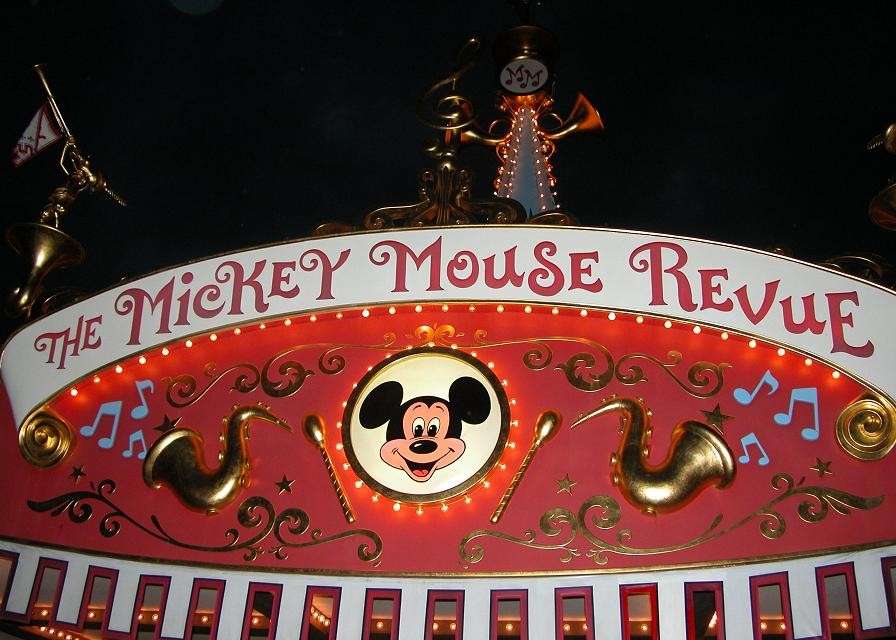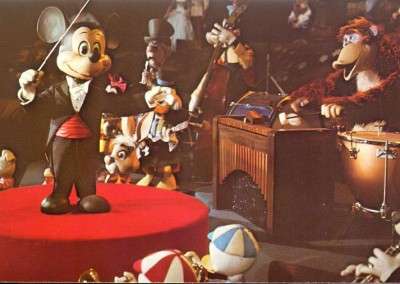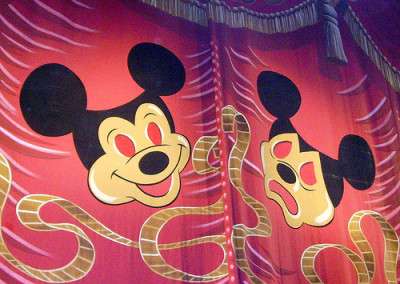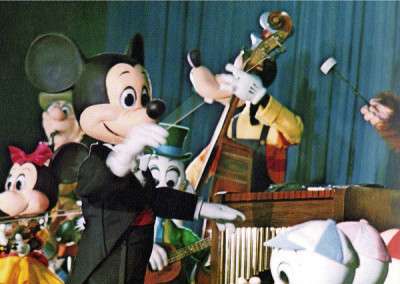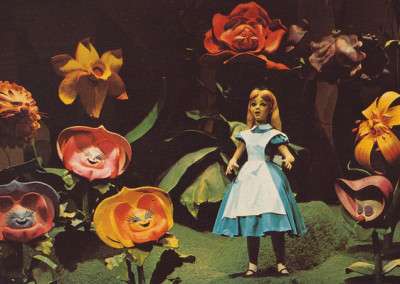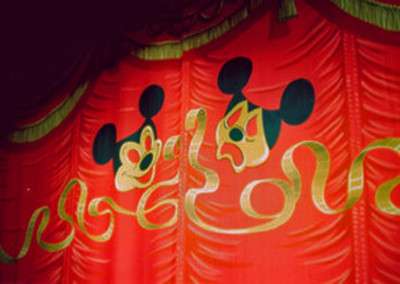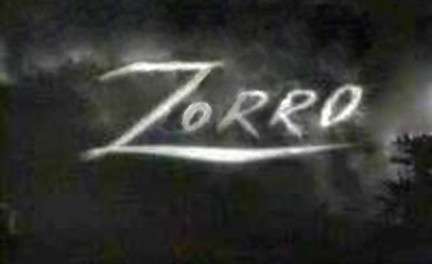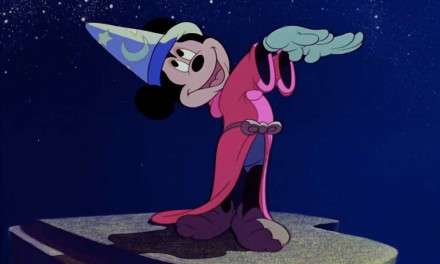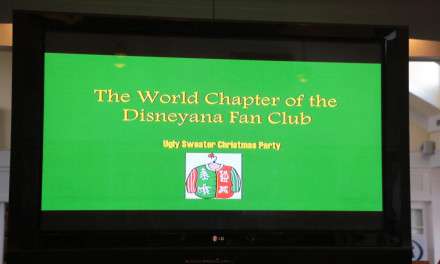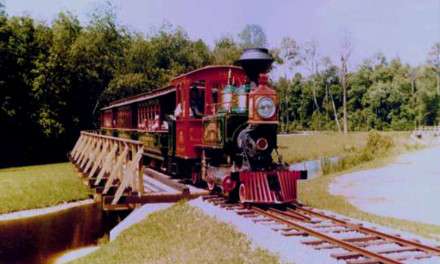Remember if you can all the attractions that have gone by the wayside at the Disney parks worldwide. From the beginning at Disneyland up till today, so many iconic and memorable rides for whatever reason are lost to time. Many classics, such as EPCOT’s opening day show, Kitchen Kabaret, Mr. Toads Wild Ride (In WDW), The Swan Boat Rides, World of Motion, Tapestry of Nations parade and so much more. But the one attraction that is gone, which was the quintessential Walt Disney, his Legacy and how it all began was the opening day attraction, October 1st, 1971 of the Audioanimatronic show called “The Mickey Mouse Revue” This “E” ticket show of Mickey and an orchestra over 73 different Disney animated characters playing (At the time) classic Disney song scores from past features, along with scenes from those filmed, all around the stage.
The idea of such a show was of course, originally Walt’s himself. In an interview in 1962 with Newsweek magazine, Walt told of a plan for an attraction at Disneyland comprising of “all the Disney Characters, so everyone could see them… I have in mind a theater, and the figures will not only put on the show but be sitting in the boxes with the visitors, heckling. I don’t know just when I’ll do that” Although Walt never did build that attraction, about ten years later, his dream opened at the Magic Kingdom in Florida.
Though Walt had the original spark, the Mickey Mouse Revue was actually gleaned from the mind of Disney Legend and Imagineer, Bill Justice. Other Imagineers instrumental in the show were John Hench, Blaine Gibson and Wathel Rogers. Here are Bill Justice’s words from an interview with Disney Historian Jim Korkis… “WED had designed some imaginative shows for the parks, but we seemed to be getting away from our heritage. Pirates of the Caribbean were a big hit, but what did it have to do with Disney? What we needed was a reminder of what Walt had accomplished. I pulled out a sheet of paper and got to work.
“Mickey Mouse would have to be the main figure. Yet some mention must be made of our great animated classics. I made sketches of all the characters I thought should appear. Then, I called upon my modeling skills to build a one-16th-inch scale paper cut-out model of what I wanted. This was before photo-copying machines with reducing capabilities, so I had to make all the drawings in scale. Many of the figures had to be drawn, a quarter-inch high. The entire set was about 18-inches long by 3.5-inches high. But this model was a good tool for planning the show sequence and experimenting with different scenes.
“Once I thought I had a winner, it was time for a bigger model. I recruited some craftsmen and we built a room size miniature theater with a stage about twelve feet wide. Blaine Gibson and his assistants sculpted all the figures to one quarter inch scale from my drawings. Everything worked except the figures themselves—lighting, turntables, curtains, sound tracks. When we were done, I notified my bosses. They invited Roy O. Disney to see the results of our work. The show we had in mind was this:
“Mickey Mouse would lead an orchestra of Studio characters through a medley of Disney tunes. Then on the sides of the stage and behind the orchestra, scenes from our most popular animated features would appear one by one. Mickey and his orchestra would close the performance. “Roy looked the model over, then paid me the best compliment I ever had in my career: ‘This is the kind of show we should spend our money on.’ That’s how ‘The Mickey Mouse Revue’ was born.
One mistake was made however during the theater’ construction at Walt Disney World. An idea for a pre-show emerged, and the area for this was outside the main theater. Only problem was the pre-show held only 300 guests while the theater could seat 504. And it was too late to make any changes. The show was hugely popular with guests and ran until September 14th, 1980. The theater was renamed the Fantasyland Theater. Other attractions were “Magic Journeys”, “The Legend of the Lion King, and the current show, “Mickey’s Philharmagic”. Some of the reasons for its closure were it never filled to capacity. That was difficult to do since the preshow held only 300 and the theater seats 504. Also, Tokyo Disneyland wanted the attraction. The Japanese always loved “Cute little things” and did not have time to fabricate a new Revue, so after closing here, it was dismantled and reassembled in Tokyo Disneyland. It opened there on April 15th, 1983 and closed on May 25th, 2009. It was replaced by Mickey’s Philharmagic.
The Show…
The pre-show was entered through a lobby, painted in pink and rose. French Trompe-l’œil (Meaning “deceive the eye”, is a technique that uses optical illusion that depicts the paintings in three dimensions) pictures of Mickey and Minnie from some of their famous roles were on the walls. The pre-show theater was through a small portal into the room with several viewing platforms. The eight minute movie covered Mickey’s career and how Walt used sound in his films. At the end of the film, attention was on Mickey as host of the Disney Parks. There was a live-action film of Disney Characters coming out of Sleeping Beauty Castle, and then Mickey invites the guests to follow him into the theater, saying…”Come along folks, it’s time for the Mickey Mouse Musical Revue”
The Main Show…
The main show theater was an 86’ long with 13 rows of seats. The stage was fringed by two smaller stages, aping box seats. As the room darkened, sound of an orchestra tuning their instruments can be heard. Mickey soon rose on a pedestal, followed by the orchestra behind and around him. The orchestra was comprised of 23 different Audioanimatronic Toon characters. The orchestra played many classic Disney songs. Each brace of songs was accompanied by different scenes. As Heigh-Ho and Whistle While you Work, the Dwarfs could be seen singing. When Dumbo began playing “Who’s Afraid of the Big Bad Wolf?” the Wolf’s shadow was shown sneaking across the rear curtain. On the right, you saw the Three Little Pigs in Practical Pigs house. Next, Snow White, sitting on a hillside sang a version of “I’m Wishing”. At different times and songs during the show, other sections of rising curtain revealed other characters.
Next, the curtain rose on Alice and the Flowers. As Alice sung the Song, “All in the Golden Afternoon”, the flowers swayed in rhythm as they and Alice sang. This was followed by the “Three Caballeros”. This segment was the most comical and animated. As a flying serape arose from the floor to the left of the orchestra, pistol shots were heard. Singing their theme song was Jose Carioca, Panchito and Donald. Every time Panchito fired his guns, sparks of light went flashing across the room. The lights go out on the serape and Panchito and Jose are singing on one of the small stages on the right, Panchito fires again and Donald appears singing on the left stage. Back and forth they go between stages on Panchito’s pistol fire, and then they are back on the serape, to complete their song, finally to disappear.
The Curtain rose on the left of the stage; you saw Cinderella and the Fairy Godmother. Fairy Godmother was waving her wand and singing “Bibbidi-Bobbidi-Boo. Cinderella was then transformed into the Princess we all know. A projection of Prince Charming and Cinderella, both singing “So this is Love” was seen on the curtain as it closed as they danced with flowers framing them around the scene. As the show neared the finale, the curtain rose and Brer Rabbit and Brer Bear were seen, rising on the right of the orchestra from the pit, singing “Zip-a-Dee-Doo-Dah”. While singing, the orchestra came into view; here all the characters could be seen at the same time.
Gone were the houses of the Seven Dwarfs and 3 Little Pigs, with a beautiful sky scene in the background. All the characters sang together as Prince Charming and Cinderella stood together and a rainbow flashed across the horizon, all while the song and orchestra reached a zenith. The stage now fell dark except for Mickey Mouse in a spotlight. As Mickey turned toward the crowd, as he and the entire cast of characters sung the “Mickey Mouse Club Alma Mater” Then all the characters disappeared and Mickey says… Thank you, folks. That concludes our show. We hope you enjoyed it.” He takes a bow and the curtain closes.
Several characters from the show are re-purposed into other venues. The Three Caballeros are finally in the “Gran Fiesta Tour” attraction at the Mexican pavilion, premiering on December 4th, 2015. During the 1984 renovation of the “Alice in Wonderland” dark ride at Disneyland, the Alice figure is from the Revue. There are also Flower Garden heads of the March Hare, Alice and the Mad Hatter.
Songs in the show were… “Overture: Heigh Ho/Whistle While You Work/When You Wish Upon a Star/Hi-Diddle-Dee-Dee”, “Who’s Afraid of The Big Bad Wolf”‘ – The Three Little Pigs, “I’m Wishing” – Snow White, “The Silly Song” – The Seven Dwarfs, “All in The Golden Afternoon” – Alice and The Flowers, “The Three Caballeros” Donald Duck, Jose Carioca and Panchito Pistoles, “Bibbidi-Bobbidi-Boo” – Fairy Godmother, “So This is Love” – Cinderella and Prince Charming, “Zip-a-Dee-Doo-Dah” – Brer Bear, Brer Fox, and Brer Rabbit, and finally the “Mickey Mouse Alma Mater”. There were a total of 73 characters in the show. But since some the characters were seen in different places on the stage, there were 81 total. It is interesting to note that some of the most iconic and early characters in Mickey’s career did not appear, i.e. Clara Cluck, Horace Horsecoller and the Big Bad Wolf. (Although only seen in a shadow) For those lucky enough to witness this classic and charming show, I envy you. This attraction was truly a major tribute to Walt Disney and what started it all.

